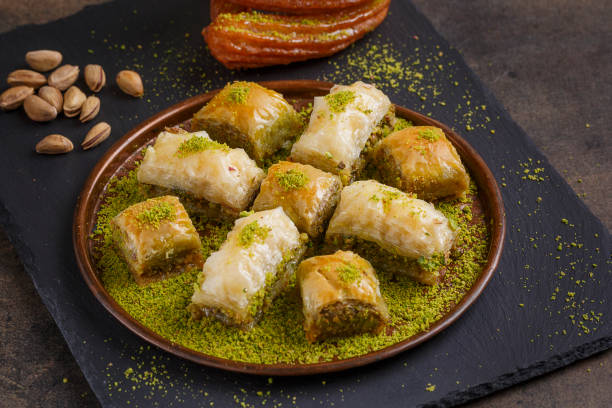Baklava, a dessert synonymous with Turkish culture, holds a storied place in the hearts and palates of those who savor it. This flaky, syrup-drenched pastry has transcended centuries, remaining a symbol of opulence, celebration, and culinary artistry. In this blog, we’ll dive into the world of traditional Turkish baklava and explore how modern baklava innovations have added a fresh twist to this timeless treat.
The Roots of Turkish Baklava
Baklava’s history is as layered as its pastry sheets. Though its origins are debated, many culinary historians trace it back to the kitchens of the Ottoman Empire. Over time, it became an integral part of Turkish cuisine, often associated with special occasions such as weddings, religious festivals, and family gatherings.
The traditional Turkish baklava is crafted with painstaking precision. Its foundation is a stack of ultra-thin phyllo dough sheets, brushed generously with melted butter. A filling of finely chopped nuts, typically pistachios or walnuts, is layered in between. After baking to a golden perfection, the dessert is drenched in a sugar-based syrup, often infused with lemon juice to balance the sweetness.
Regional Variations of Traditional Baklava
Türkiye’s diverse regions have added their own flair to baklava, each bringing unique techniques and ingredients to the table. Here are a few standout styles:
Gaziantep Baklava: Hailed as the birthplace of baklava, Gaziantep is famous for its pistachio-filled variety. The pistachios, known locally as “boz fıstık,” are revered for their distinctive flavor and vibrant green hue.
Saray (Palace) Baklava: This luxurious variation dates back to Ottoman palaces, where extra care was taken to create ultra-thin dough and premium fillings.
Kuru Baklava (Dry Baklava): This less syrupy option is ideal for longer shelf life and is a favorite among travelers.
Fıstıklı Sarma (Pistachio Rolls): A variation where pistachio paste is rolled into sheets of phyllo, offering a concentrated nutty flavor.
Modern Twists on Baklava
In recent years, baklava has undergone a renaissance. Chefs and confectioners worldwide have embraced the challenge of reinventing this classic. Here are some notable modern variations:
Chocolate Baklava: Layers of chocolate-infused phyllo dough or a drizzle of rich chocolate sauce provide a decadent twist for cocoa lovers.
Fruit-Infused Baklava: Some modern baklavas incorporate dried fruits like apricots, figs, or cranberries into the nut mixture, adding a tangy sweetness.
Savory Baklava: Breaking the mold, savory versions use ingredients like cheese, spinach, or even minced meat, turning this dessert into a surprising appetizer.
Vegan Baklava: With plant-based butter and sweeteners, vegan baklava caters to those with dietary restrictions without compromising on flavor.
Baklava Ice Cream: Pairing baklava with creamy, rich ice cream has become a popular way to enjoy the dessert in warmer months.
Craftsmanship Behind the Flavor
Whether traditional or modern, baklava’s magic lies in its preparation. Master baklava makers, known as “baklavacıs,” undergo rigorous training to perfect the dough’s thinness, the filling’s balance, and the syrup’s consistency. This attention to detail ensures every bite is a harmonious blend of crispiness, nuttiness, and sweetness.
Beyond Baklava: Lokum (Turkish Delight)
No discussion of Turkish sweets would be complete without mentioning lokum, also known as Turkish delight. These chewy, fragrant confections come in various flavors, including rose, pomegranate, and pistachio, and perfectly complement a serving of baklava.
For those seeking the finest lokum varieties, Exporgin.com offers an exquisite selection. Explore their collection to discover flavors that elevate your dessert experience.


